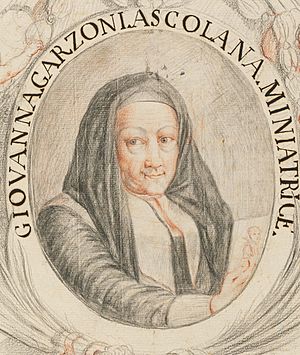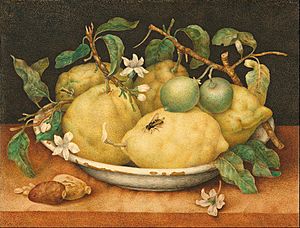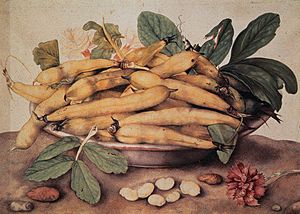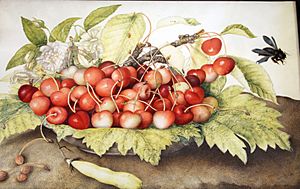Giovanna Garzoni facts for kids
Giovanna Garzoni (1600–1670) was a talented Italian painter from the Baroque period. She started her art career by painting religious stories and myths. But she became famous for her amazing paintings of plants, flowers, and fruits. She used special paints called tempera and watercolour.
People loved her artwork because it was very precise and balanced. She painted objects exactly as they looked. Giovanna was also very creative. She often combined interesting items in her paintings, like fancy Asian porcelain, unique seashells, and different kinds of plants. She was sometimes called "the Chaste Giovanna" because she decided to remain unmarried.
Contents
Early Life and Training
Giovanna Garzoni was born in 1600 in a town called Ascoli Piceno in Italy. Her parents were Giacomo Garzoni and Isabetta Gaia. Both her parents came from Venice, and some people believe they were from a family of painters.
Giovanna's grandfather, Nicola, and her uncle, Vincenzo, were both goldsmiths. Another uncle, Pietro Gaia, was a painter. Many historians think Giovanna started learning to paint from her uncle Pietro before she was 15 years old. Giovanna also had a brother named Mattio, and they often traveled together during her career.
Giovanna's Art Career

Giovanna Garzoni's first known art job was in Rome, where she grew up. In 1616, a chemist named Giovanni Vorvino asked her to paint a book of plants, called a herbarium.
Between 1618 and 1620, Giovanna visited the Medici family's court in Florence. She probably met another famous female artist, Artemisia Gentileschi, there. In 1620, Giovanna went to Venice. She painted a picture of Saint Andrew for a church in Venice.
Giovanna stayed in Venice for a few more years. During this time, she went to a calligraphy school. Calligraphy is the art of beautiful handwriting. After her studies, Giovanna created a book of fancy writing styles. It was filled with pictures of birds, flowers, and insects.
Travels and Famous Clients
After finishing school, Giovanna and her brother Mattio left Venice in 1630. They went to Naples, where she worked for a Spanish ruler called the Duke of Alcalá. Giovanna stayed in Naples for about a year.
In 1631, she returned to Rome. But she didn't stay long! Christina of France really wanted Giovanna to come to Turin. She wanted Giovanna to be a miniaturist for her court. A miniaturist is an artist who paints very small, detailed pictures. Giovanna arrived in Turin in 1632 and lived there until 1637.
After Turin, Giovanna became familiar with the art of other painters like Fede Galizia. A few years later, in 1640, Giovanna went to Paris. She stayed there until 1642, then returned to Rome.
Giovanna traveled back and forth between Rome and Florence until 1651. Her main clients were members of the important Medici Family. This included Grand Duke Ferdinando II and Cardinal Giovan Carlo.
Settling in Rome
After working for the Medici Court, Giovanna decided to live in Rome permanently in 1651. She continued to create art for the Florentine Court. Besides painting, Giovanna also attended the Accademia di San Luca. This was an important art school in Rome where artists learned and shared ideas.
Many historians say that Giovanna's paintings were so popular that she could ask for any price she wanted for her artwork!
Notable Artworks and Clients
Giovanna created many beautiful pieces of art. Here are some of her well-known works:
- Self-portrait as Apollo: This early painting shows Giovanna looking calm and thoughtful.
- Citrus Fruit Studies: Around 1626-1633, a collector named Cassiano dal Pozzo bought several of her detailed paintings of citrus fruits. She painted them using watercolor on parchment for a book about fruits.
- Portrait Miniature of Zaga Christ: In 1635, Giovanna made the first known tiny portrait of a Black person. It was of an Ethiopian traveler named Zaga Christ. He might have asked her to paint it as a gift for the French court.
Works for the Medici Family
The Medici family commissioned many of Giovanna's artworks.
- Plate with White Beans: This painting, made between 1650 and 1662, shows white beans at different stages of growth. It is a very realistic study of nature. You can see it in the Galleria Palatina in Florence.
- Still Life with a Basket of Fruit, a Vase with Carnations and Shells on a Table: This painting is one of twenty small still-life pictures Giovanna made for the Medici family. It shows beautiful carnations, seashells, and a basket of fruit. Because of her work for the Medici Court, Giovanna became very popular for her paintings of nature. This artwork is now in a collection in Washington, DC.
Other Important Works
- Portrait of Carlo Emanuele I, Duke of Savoy: Giovanna painted this portrait between 1623 and 1637. She was invited to work for the court in Turin by Christina of France. This painting is now in the Palazzo Reale in Turin.
Giovanna also created two important notebooks. One is at Dumbarton Oaks in Washington DC. It includes a self-portrait of Giovanna when she was older, plus many studies of plants. Another notebook is held by the Accademia di San Luca. This one has studies of flowers and still-life paintings.
Personal Life
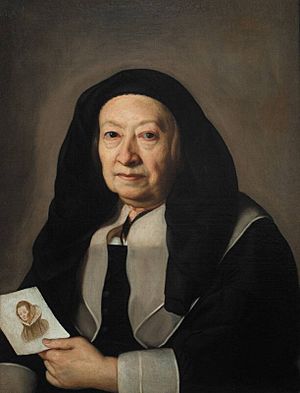
Historians believe that Giovanna Garzoni never married. However, some people think she might have been married briefly to a painter named Tiberio Tinelli in 1622. If they were married, it was only for a short time, and they may have separated by 1624.
Death and Legacy
In 1666, Giovanna Garzoni made a will. She left her money and property to the Church of Santa Martina. She asked to be buried in that church. Giovanna died in Rome in February 1670 when she was 70 years old.
Her tomb is still at the Church of Santa Martina. However, she was not buried there until 1698, which was almost 29 years after she passed away. A portrait of Giovanna Garzoni, painted by Giuseppe Ghezzi, is also located at the Accademia di San Luca.
Exhibitions
- “The immensity of the universe” in the art of Giovanna Garzoni, Florence, Gallerie degli Uffizi, Palazzo Pitti, Andito degli Angiolini, May 28 - June 28, 2020.
- The Ladies of Art. Stories of women between the 1500s and 1600s, Milan, Palazzo Reale, March 2 - August 22, 2021.
- By Her Hand: Artemisia Gentileschi and Women Artists in Italy, 1500–1800, Wadsworth Atheneum and the Detroit Institute of Arts, September 30, 2021 – January 9, 2022.
See also
 In Spanish: Giovanna Garzoni para niños
In Spanish: Giovanna Garzoni para niños


